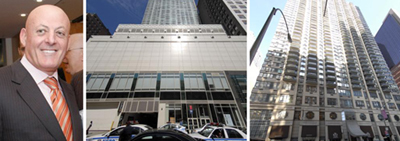Trending
Like many new investment vehicles, $1B Stonehenge fund faces challenges
Stonehenge marketing materials lay out investment strategy and goals

From left: Ofer Yardeni, 315 West 33rd Street and 235 West 48th Street (building photos’ source: PropertyShark)
The current investment sales market, with many buyers and few sellers, will make acquisitions difficult for the large rental firm Stonehenge Partners, which is seeking to raise a $1 billion fund to buy apartment buildings or related real estate debt in New York City, real estate analysts say.
Ofer Yardeni, a managing director and co-founder of Midtown-based Stonehenge, told an audience last week at the Massey Knakal Multi-family Summit that he planned to raise the private equity fund, noting that rent-regulated buildings provide a good opportunity to increase the value of Manhattan real estate as tenants leave and rents are increased to market levels.
The Real Deal obtained a copy of a presentation prepared in the second quarter of 2010 as marketing material to target potential investors for the 10-year fund called the Stonehenge Real Estate Partnership IV (see document below).
The document provides a rare peek into the creation of a private fund, including the fees Stonehenge hopes to collect, its anticipated returns and the type of property it is planning to buy.
Experts told The Real Deal there are a number of obstacles for any new fund today, including that far fewer properties have come to the market than anticipated and that those that do are often sold behind the scenes through a private debt sale.
“They are going to have trouble finding products to buy,” Dan Fasulo, managing director of real estate data firm Real Capital Analytics, said. Stonehenge would have to try and pry away apartments from within larger portfolios and buy debt and mezzanine loans, he said. “That should help get a little more money out, but it is not easy. I have people calling here screaming that they can’t find distressed [assets] to buy.”
In fact a much older New York family-owned company, the Durst Organization, announced in 2008 that it would raise a $300 million fund for acquisitions, but so far has only purchased two distressed notes, on 855 Sixth Avenue and another in Long Island City.
In addition, some experts speculated that the $1 billion fund would in reality give Stonehenge the purchasing power of up to $2.8 billion because it would be leveraged by as much as 65 percent in debt.
That would make the fund a dominant player in New York City, in a market where just $1.8 billion worth of apartment buildings have sold this year through August, data from Real Capital Analytics shows.
But Fasulo added that Stonehenge has a successful track record of buying properties and increasing their values in Manhattan, which helps in both raising money and closing deals. Stonehenge did not return requests for comment.
The document said the fund’s strategy was to “acquire and manage well-positioned residential apartment buildings (or related debt and/or securities) located in New York City that offer stable, recurring long-term cash flows as well as value creation opportunities through active management, capital improvements, repositioning, unused density, or market inefficiencies.”
The presentation shows how profitable managing a fund can be. Stonehenge is asking investors to pay it 1.5 percent of their committed capital before it is used, and later 1.5 percent of the capital spent making acquisitions. In addition, it would likely charge a property management fee of 3 to 5 percent, as many other owners do. For the investors, the fund hoped to provide a 12 percent internal rate of return.
Several real estate insiders said the expectation from investors would be to at least double their money while it was tied up for as much as a decade in the partnership.
The numbers in the presentation were similar to those found in other funds of its size, they said. In addition, investment fees could go down as the final partnership agreement is negotiated with investors.
Barry Hersh, a clinical associate professor at the Schack Institute of Real Estate at New York University, said another risk factor is the potential for more tenant-friendly rent laws in Albany, which could make it more difficult to convert rent-regulated apartments to market-rate.
Stonehenge currently owns and manages a $1.6 billion portfolio of 19 properties with a total of 2,700 apartment units, all in Manhattan, including the Olivia at 315 West 33rd Street with 333 Apartments And Ritz Plaza at 235 West 48th Street with 479 units, the marketing document shows.
Stonehenge is also converting a rental apartment to a condominium at the 10-story brick Merritt House at 167 East 82nd Street.
Stonehenge has had success recently with its last fund. In 2007, the company created the $500 million Stonehenge Fund III, to invest in residential and commercial real estate in the New York metro area. By 2008 it had invested more than $200 million in three Manhattan properties including 141 East 33rd Street. This year, that fund was used to make the $67 million purchase of the former St. Vincent’s Hospital residential building at 555 Sixth Avenue in Greenwich Village.
Stonehenge real estate fund marketing materials




